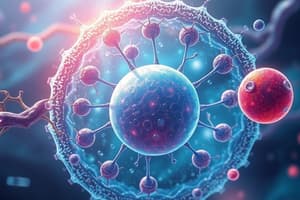Podcast
Questions and Answers
Which process describes the response of blood flow directed away from the skin surface?
Which process describes the response of blood flow directed away from the skin surface?
- Hypothalamic regulation
- Thermoregulation
- Vasoconstriction (correct)
- Vasodilation
What is the effect of shivering in endotherms?
What is the effect of shivering in endotherms?
- Decreased metabolic rate
- Vasodilation
- Increased metabolic rate (correct)
- Hair flattening
What role does the hypothalamus play in thermoregulation?
What role does the hypothalamus play in thermoregulation?
- It functions as a detector for temperature changes. (correct)
- It solely controls hormonal responses.
- It acts only as a behavioral mechanism.
- It suppresses the autonomic nervous system.
Which of the following is a physiological mechanism for cooling in endotherms?
Which of the following is a physiological mechanism for cooling in endotherms?
Which of these actions is NOT a behavioral response to heat in endotherms?
Which of these actions is NOT a behavioral response to heat in endotherms?
What is the basal metabolic rate (BMR)?
What is the basal metabolic rate (BMR)?
What physiological response occurs during warming in endotherms?
What physiological response occurs during warming in endotherms?
Which system is involved in voluntary behavioral mechanisms for temperature control?
Which system is involved in voluntary behavioral mechanisms for temperature control?
What happens to the metabolic rate during cooling in endotherms?
What happens to the metabolic rate during cooling in endotherms?
Which of the following characteristics is NOT associated with ectothermic animals?
Which of the following characteristics is NOT associated with ectothermic animals?
Which hormone is associated with increased metabolism in response to temperature changes?
Which hormone is associated with increased metabolism in response to temperature changes?
Which statement about endothermic animals is true?
Which statement about endothermic animals is true?
What type of behavioral adaptation do ectothermic animals use to warm up?
What type of behavioral adaptation do ectothermic animals use to warm up?
How do ectothermic aquatic animals primarily regulate their body temperature?
How do ectothermic aquatic animals primarily regulate their body temperature?
Which of the following is a common misconception about ectothermic animals?
Which of the following is a common misconception about ectothermic animals?
What is a primary reason why ectothermic animals require less food than endothermic animals?
What is a primary reason why ectothermic animals require less food than endothermic animals?
Which of the following behaviors do ectothermic land animals exhibit to cool down?
Which of the following behaviors do ectothermic land animals exhibit to cool down?
Which group of animals is incorrectly classified based on temperature regulation?
Which group of animals is incorrectly classified based on temperature regulation?
Which statement best contrasts ectothermic and endothermic animals?
Which statement best contrasts ectothermic and endothermic animals?
What is the primary purpose of homeostasis in the body?
What is the primary purpose of homeostasis in the body?
Which of the following best describes the term 'homeostasis'?
Which of the following best describes the term 'homeostasis'?
Which of these components is NOT typically involved in the internal environment that supports homeostasis?
Which of these components is NOT typically involved in the internal environment that supports homeostasis?
Why is an internal environment necessary for large animals?
Why is an internal environment necessary for large animals?
What percentage of water is typically found in human cells, contributing to homeostasis?
What percentage of water is typically found in human cells, contributing to homeostasis?
Which of the following aspects is NOT a factor in maintaining homeostasis?
Which of the following aspects is NOT a factor in maintaining homeostasis?
What is the significance of having a relative stable internal environment for cells?
What is the significance of having a relative stable internal environment for cells?
Which of the following statements about homeostasis is correct?
Which of the following statements about homeostasis is correct?
What role does interstitial fluid play in homeostasis?
What role does interstitial fluid play in homeostasis?
In the context of homeostasis, what is the significance of osmotic pressure?
In the context of homeostasis, what is the significance of osmotic pressure?
What is the primary role of insulin and glucagon in blood glucose management?
What is the primary role of insulin and glucagon in blood glucose management?
How does the liver respond to high blood glucose levels?
How does the liver respond to high blood glucose levels?
Which statement accurately describes temperature sensitivity in physiological processes?
Which statement accurately describes temperature sensitivity in physiological processes?
What defines an organism as 'homeothermic'?
What defines an organism as 'homeothermic'?
What is NOT a corrective mechanism in maintaining homeostasis?
What is NOT a corrective mechanism in maintaining homeostasis?
Which statement is true regarding the sources of heat for animals?
Which statement is true regarding the sources of heat for animals?
What is the consequence of having blood glucose levels outside of the norm?
What is the consequence of having blood glucose levels outside of the norm?
Which physiological range is critical for optimal cell function?
Which physiological range is critical for optimal cell function?
In what way is blood glucose controlled?
In what way is blood glucose controlled?
What is a characteristic of poikilothermic animals?
What is a characteristic of poikilothermic animals?
Flashcards
Optimal Body Functions
Optimal Body Functions
The range of physical and chemical conditions within which the body functions best.
Homeostasis
Homeostasis
The maintenance of a stable internal environment within a defined set of parameters, even in the face of external changes.
Homeostatic Control Systems
Homeostatic Control Systems
The collection of cellular processes that keep internal conditions within a set range.
Internal Environment
Internal Environment
Signup and view all the flashcards
Plasma
Plasma
Signup and view all the flashcards
Interstitial Fluid
Interstitial Fluid
Signup and view all the flashcards
Homeostatic Regulation
Homeostatic Regulation
Signup and view all the flashcards
Auto-regulation
Auto-regulation
Signup and view all the flashcards
Dynamic Equilibrium
Dynamic Equilibrium
Signup and view all the flashcards
Homeostatic Adaptation
Homeostatic Adaptation
Signup and view all the flashcards
Negative feedback
Negative feedback
Signup and view all the flashcards
Set point
Set point
Signup and view all the flashcards
Blood glucose homeostasis
Blood glucose homeostasis
Signup and view all the flashcards
Insulin
Insulin
Signup and view all the flashcards
Glucagon
Glucagon
Signup and view all the flashcards
Optimal cell temperature
Optimal cell temperature
Signup and view all the flashcards
Homeothermy
Homeothermy
Signup and view all the flashcards
Poikilothermy
Poikilothermy
Signup and view all the flashcards
Cellular respiration
Cellular respiration
Signup and view all the flashcards
Ectothermic Animals
Ectothermic Animals
Signup and view all the flashcards
Endothermic Animals
Endothermic Animals
Signup and view all the flashcards
Thermoregulation
Thermoregulation
Signup and view all the flashcards
Behavioral Thermoregulation
Behavioral Thermoregulation
Signup and view all the flashcards
Physiological Thermoregulation
Physiological Thermoregulation
Signup and view all the flashcards
Heat Conservation
Heat Conservation
Signup and view all the flashcards
Combined Thermoregulation
Combined Thermoregulation
Signup and view all the flashcards
Social Insects
Social Insects
Signup and view all the flashcards
Hot Fish
Hot Fish
Signup and view all the flashcards
What is the thermoneutral zone?
What is the thermoneutral zone?
Signup and view all the flashcards
What is the basal metabolic rate (BMR)?
What is the basal metabolic rate (BMR)?
Signup and view all the flashcards
How do endotherms behave to warm up?
How do endotherms behave to warm up?
Signup and view all the flashcards
How do endotherms behave to cool down?
How do endotherms behave to cool down?
Signup and view all the flashcards
What are some physiological ways endotherms warm up?
What are some physiological ways endotherms warm up?
Signup and view all the flashcards
What are some physiological ways endotherms cool down?
What are some physiological ways endotherms cool down?
Signup and view all the flashcards
What is vasoconstriction?
What is vasoconstriction?
Signup and view all the flashcards
What is vasodilation?
What is vasodilation?
Signup and view all the flashcards
What is negative feedback in the context of body temperature?
What is negative feedback in the context of body temperature?
Signup and view all the flashcards
How does the body control its temperature using negative feedback?
How does the body control its temperature using negative feedback?
Signup and view all the flashcards
Study Notes
Homeostasis
- Homeostasis is the maintenance of a stable but dynamic physiological state within set parameters, achieved by the body's auto-regulatory processes.
- The body functions optimally under a narrow range of physical and biochemical conditions, including glucose, ion levels, osmotic pressure, relative amounts of water and solutes, CO2 levels, and temperature.
- Homeostasis is crucial for the survival of cells in complex organisms, as cells are largely isolated from external environments.
- The internal environment of large animals, containing nutrients and absorbing waste, provides cells with a stable environment enabling them to function correctly.
- In humans, approximately 60% of the body is composed of water, with 60% of that water found within cells, and the remaining 20% is plasma and 80% interstitial fluid.
Control Mechanisms
- Homeostasis is regulated by two key processes
- Control of blood glucose by hormones
- Control of body temperature by behavioral and physiological mechanisms
Negative Feedback
- Negative feedback loops help to maintain physiological processes within acceptable parameters.
Temperature Sensitivity
- Cells function optimally within a temperature range of approximately 0°C to 40°C.
- Biochemical reactions can have different responses to changes in temperature.
- Some reactions are temperature-sensitive whilst others aren’t.
- Physiological processes are temperature-sensitive.
Animals and Temperature
- Animals regulate their body temperature through various mechanisms and methods:
- Ectothermic animals gain heat from the environment; all animals except birds and mammals are ectothermic.
- Endothermic animals generate heat internally; birds and mammals are endothermic.
- Aquatic animals usually have body temperatures that are similar to water temperatures.
- Land animals can utilize their surroundings (e.g., sunlight or shade) to regulate temperature, and may exhibit more active behavior to adjust their body temperature in varying conditions.
Heat Exchange in Ectotherms
- Conduction, convection, radiation, and evaporation influence heat exchange in ectothermic animals.
Endotherms and Temperature Regulation
- Endotherms can adjust body temperature and can compensate for changing environmental temperatures by adjusting their metabolic rate.
- The basal metabolic rate (BMR) of a resting endotherm is at a low point in the 'thermoneutral zone'.
- Above or below this zone, behavior and physiological mechanisms react to maintain internal temperature and meet metabolic demands.
- Endotherms have diverse behavioral responses when body temperature fluctuates above or below the thermoneutral zone.
Control of Body Temperature by Negative Feedback
- Detectors, effectors, and negative feedback mechanisms help to regulate body temperature.
- The hypothalamus acts as a thermostat.
- Various physiological processes aid in maintaining homeostasis to stay within a set range of temperatures
- For example, shivering, vasodilation, vasoconstriction, sweating.
Studying That Suits You
Use AI to generate personalized quizzes and flashcards to suit your learning preferences.




